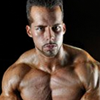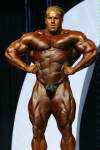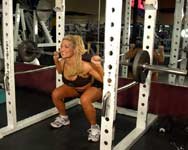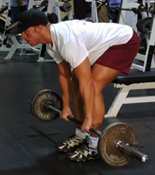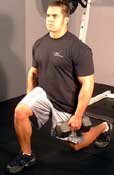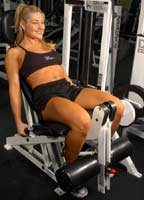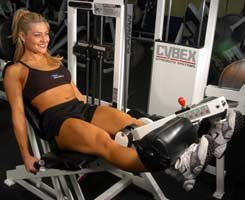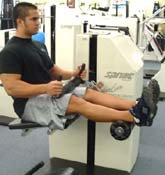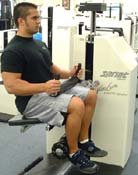Specialized Leg Hypertrophy Program
Structure and Function: Muscles Of The Thigh
The Quadriceps (Quads)
The quadriceps are the muscles of the anterior (front) leg. As the name implies, the quadriceps are made up of four muscles: the rectus femoris, vastus medialis, vastus lateralis, and vastus intermedius. All four muscles insert into the patella and tibial tuberosity via the patellar ligament and function in extension of the knee.
Rectus Femoris:
The rectus femoris lies deep to the other three muscles of the quadriceps. It is unique to this group because it is the only muscle of the four that crosses the hip.
The rectus femoris originates at the anterior inferior iliac spine (part of the pelvis) and inserts on the patella (knee bone) and tibial tuberosity via the patellar ligament. Due to this orientation, spanning the hip and knee, the rectus femoris functions in hip flexion as well as knee extension.
Vasti Muscles—Medial, Lateral, & Intermedius:
The three vasti all function together in knee flexion. The vastus medialis originates from the medial lip of the linea aspera (which means it originates mostly on the posterior femur and somewhat on the anterior aspect).
The vastus lateralis originates from the lateral lip if the linea aspera and therefore has a mostly posterior origin. This is why someone with a well-developed vastus lateralis is said to have a good "outer quad sweep."
The vastus lateralis originates from the anterior and lateral surfaces of the femur. This muscle blocks the vastus medialis from being in contact with the medial surface of the femur.
As mentioned, all four muscles of the quadriceps function in knee extension, but the last 15 degrees of extension are accomplished by only the three vasti muscles.
The Hamstrings (Hams)
The hamstrings are made up of three muscles on the posterior aspect of the thigh; they include: the semimembranosus, semitendinosus, and the two-headed biceps femoris. These muscles are often underdeveloped compared to the quadriceps. This muscle imbalance can lead to injury now and later on in life.
A bodybuilder with well-developed hamstrings allows stands out to the judges, at least at amateur shows where athletes usually lack this development.
All three hamstring muscles, except for the short head of the biceps femoris originate at the ischial tuberosity of the pelvis. Due to this common origin and relatively common insertions, all three of the muscles of the hamstrings, again except for the short head of the biceps femoris, function as hip extensors and weak abductors. All three muscles, including the short head of the biceps femoris, function as knee flexors.
Semimembranosus:
The semimembranosis is one of the two medially inserting hamstrings muscles. This muscle lies just deep to the semitendinosus, but can be clearly distinguished from the semitendinosus on a cadaver or very lean athlete. The semimembranosus inserts on the posteromedial aspect of the tibia.
Semitendinosus:
The semitendinosus, the other medial hamstring muscle, inserts on the tibial medial, just inferior to the tibial tuberosity.
Biceps Femoris—Long & Short Heads:
The long head of the biceps femoris originates in common with the semitendinosus and is joined above the knee by the short head of the biceps femoris, which originates from the linea aspera on the posterior femur. These lateral muscles unite into one tendon, which inserts on the head of the fibula.
Along with extension of the hip and flexion of the knee, the semimembranosus and semitendinosus are weak medial rotators of the thigh and knee when the leg is flexed. Both heads of the biceps femoris laterally rotate the knee when it is flexed.
An interesting point is that both of these heads participate in flexion of the knee, but the long head may only participate in the beginning of the action and relax when the leg is semiflexed.
The Program
Workout A (Monday)
- Squats: 3 x 4-6
- Stiff-Legged Deadlift: 3 x 4-6
- Dumbbell Lunges: 3 x 12-15
Or:
- Leg Extension (Single-leg): 2 X 12-15
- Seated Leg Curl (Single-leg): 2 X 12-15
Main Focus: Increasing the weight lifting on squats and stiff-legged deadlifts.
 Click Here For A Printable Log Of Workout A.
Click Here For A Printable Log Of Workout A.
Squats:
Heavy squats build big legs. Have you ever seen someone with small legs squat 500 pounds? Like I have been saying throughout the book, exercises that allow you to place the greatest load on a muscle often lead to the greatest growth. One can squat a whole lot more than they can leg extension. The squat targets primarily the quads, but also hits the glutes and hams.
It is my opinion that you should place you feet at the width apart that feels most sturdy and comfortable for you. For me, placing my feet about shoulder with apart is most comfortable and allows me to target the quads the most. When executing the squat, emphasis should be placed on keeping your back straight and not leaning forward or backward as this can place undue stress on your lower back.
Stiff-Legged Deadlift:
Stiff-legged deadlifts allow you to use a heavy load to target the hamstrings. Some people have trouble targeting the hamstrings with this exercise and say they feel it more in their lower back. In order to increase hamstring recruitment you should bend your knees slightly and during the eccentric portion of the lift, push your butt backwards to stretch the hamstrings.
As you transition into the concentric phase of the lift you want to concentrate on contracting the hamstrings and not just pulling the bar up with your lower back.
 Lunges/Single-Leg Extensions and Curl:
Lunges/Single-Leg Extensions and Curl:
Basically these exercises are done to hit each leg individually. One could simply do more squats and stiff-legged deadlifts, but those exercises are very taxing and these exercises hit the legs differently. Leg extensions and leg curls are single joint movements, which allow you to isolate the muscles of the quads and hams respectively.
Workout B (Thursday)
- Leg Press: 3 x 6-10
- Leg Extension: 3 x 6-10
- Leg Curl: 3 x 6-10
- Hack Squat: 1 x 20 or 1 x 6-10 dropset consisting of 3 decrements in weight
 Click Here For A Printable Log Of Workout B.
Click Here For A Printable Log Of Workout B.
No real explanation is needed for this routine. It is a "lighter" routine done between the heavy squat and stiff leg deadlift workout.
This workout will allow you to create another stimulus for growth without overly hampering recovery. Focus should be placed on using a full range of motion (ROM) on all exercises. Instead of loading up the leg press with plate after plate and performing 1/2 reps, decrease the weight you put on the press and use a full ROM.
About The Author:
Derek "The Beast" Charlebois is an ACE certified personal trainer, competitive bodybuilder, and holds a Bachelor's degree in Exercise Science from The University of Michigan. Derek is the Promotions Coordinator/R&D at Scivation/Primaforce and is involved in coordinating promotions, research and development, advertising, and marketing.
